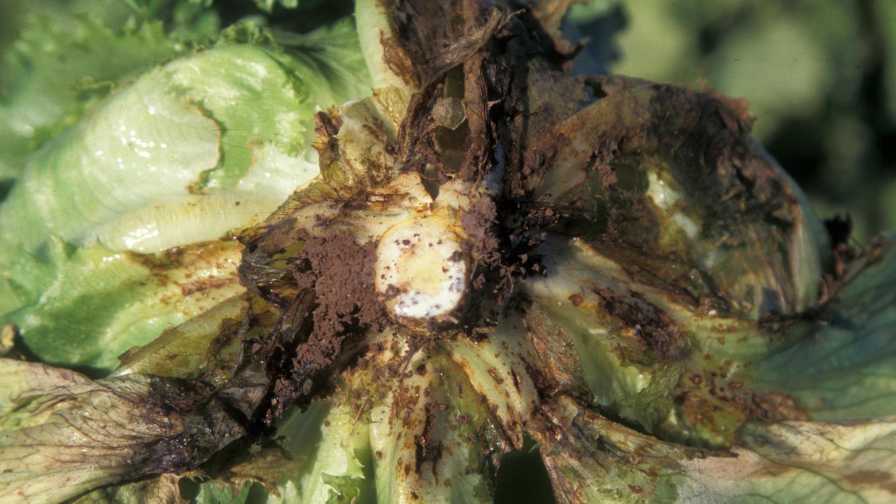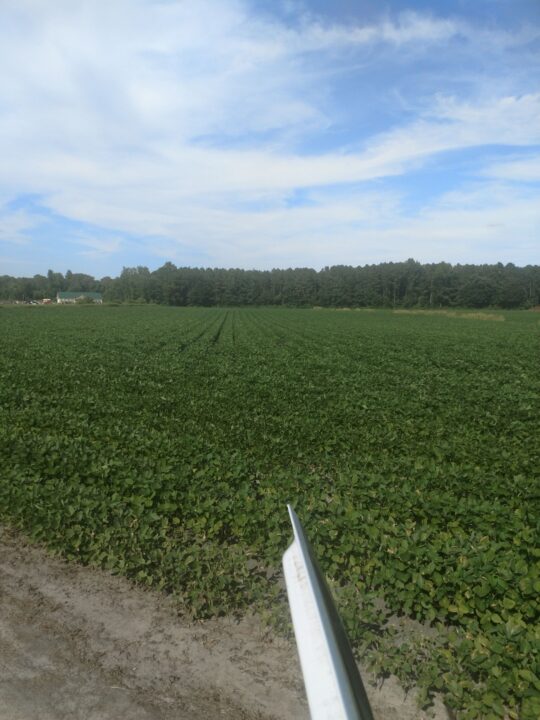Bottom Rot Leaving Some Florida Lettuce Growers In A Lurch
Disease Specs
With this season’s heavy rains, Florida growers are reporting severe problems with bottom rot in lettuce. Bottom rot is caused by the soil-borne fungus Rhizoctonia solani, and might be found wherever lettuce is grown.

Photo by Gerald Holmes
Identification
Early symptoms include wilting of the outer leaves. Infected plants have sunken, reddish-brown lesions of varying sizes on leaf petioles and midribs touching the soil. These spots can be small or can cover the entire petiole/midrib area. White- to brown-colored mycelium may grow in the lesions.
If conditions are unfavorable for the fungus, the rust-colored lesions on the petioles will dry and turn chocolate brown. Under warm, wet conditions, the fungus will continue to grow upward into the leaf blades, destroying them as it grows from leaf to leaf. Small, irregularly shaped cinnamon brown to dark brown resting structures, known as sclerotia, might be seen on the head and on the soil under it.
When plants are cut, the lesions are visible on the bottom of the head. When only the outer leaves are affected, they can be removed in the field and the heads can be harvested. If the fungus has invaded the entire head or the lesions are too deep, the plants are unmarketable and must be discarded.
Survival And Spread
Infection occurs when sclerotia germinate and produce mycelium that penetrates healthy or wounded tissue. The pathogen infects lettuce over a wide range of temperatures, but is favored by warm moist conditions.
Rhizoctonia solani is a very common soil inhabitant that commonly infects numerous plant species. The pathogen survives between lettuce crops as sclerotia or mycelium in soil and crop debris, or on alternate hosts. It also can be introduced into fields by wind- or water-disseminated spores. Rhizoctonia survives almost indefinitely in soils because of its ability to colonize soil organic matter in absence of a living host.
Management Methods
Since the pathogen typically survives between crops on infected plant debris, sanitation is important and all residues should be disked under and allowed to decompose. Growers should pursue a combination of cultural practices to help control the disease.
Practice a three-year or longer rotation to non-hosts. Destroy crop residues by plowing deeply after harvest to reduce pathogen survival. Practice effective weed control to eliminate alternate hosts between lettuce crops. Use of high beds to promote air movement, drainage, and minimize foliage contact with the soil is recommended to manage this disease.
Lettuce varieties with an upright architecture, such as Romaine, also will reduce foliage contact with the soil and lower the chance of infection. Avoid irrigation near harvest.
Control for the disease must be preventative. Applications of iprodione or boscalid (Endura, BASF) being made to the plants and beds at or just after thinning are helpful in prevent infection preventing infections especially in plantings when temperatures are favorable for disease development.
Growers should be sure to rotate between modes of action and consult UF/IFAS recommendations for currently labeled fungicides for bottom rot control on lettuce in Florida.










